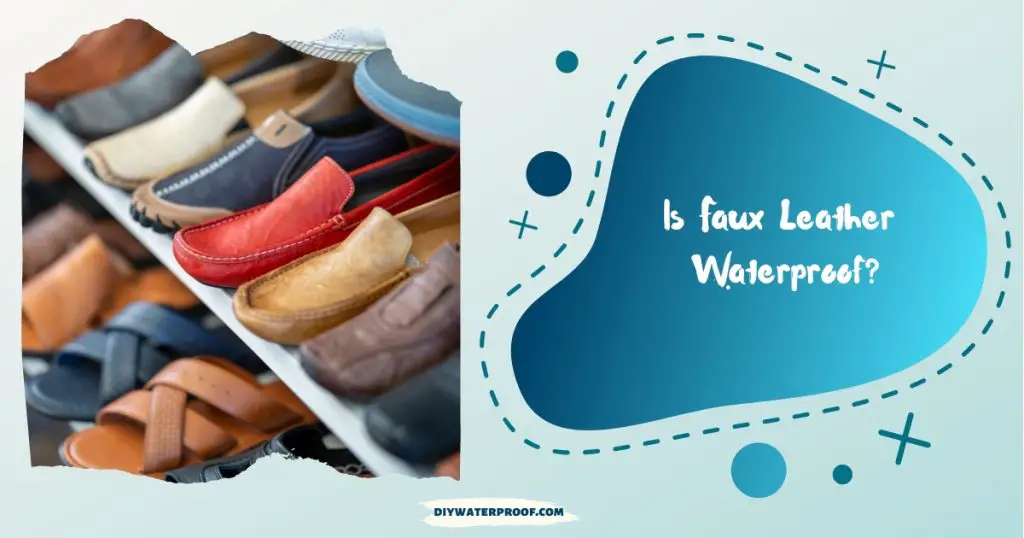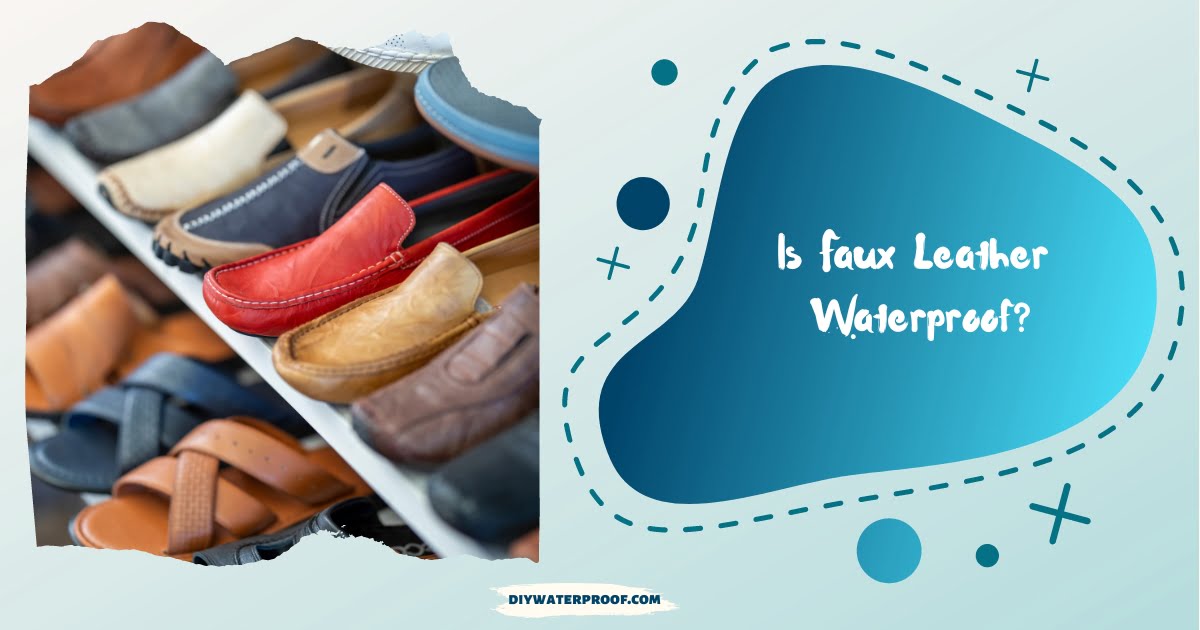Is faux leather waterproof? The answer is both yes and no. Faux leather can be waterproof, but not all types are.
PU faux leather tends to be more water-resistant due to its plastic base, while PVC faux leather is less porous and more likely to withstand exposure to water.

However, both types of faux leather can eventually start to peel and crack when exposed to water for extended periods of time.
So, while you may be able to find some faux leather products that are marketed as “waterproof,” it’s important to note that they will still have limitations.
How Do You Know if a Faux Leather Item is Waterproof?
Faux leather, also known as synthetic leather or vegan leather, is a popular alternative to genuine leather due to its affordability and animal-free production.
However, one common concern when it comes to faux leather is whether or not it is waterproof.
The short answer is: it depends. Faux leather itself is not inherently waterproof, but some certain types and finishes can make it water-resistant or even waterproof.
Let’s take a closer look at the different factors that determine the waterproofness of faux leather.
1. Material
The most critical factor in determining whether faux leather is waterproof is its material composition. Faux leather can be made from polyurethane (PU), polyvinyl chloride (PVC), and microfiber.
PU and PVC are commonly used in faux leather production, and they have different degrees of waterproofness.
PU faux leather is generally more water-resistant than PVC faux leather.
This is because PU has a tighter molecular structure, making it less porous and allowing less water to seep. On the other hand, PVC is more porous and can absorb water, making it less waterproof.
2. Finish
Apart from the material, the finish of faux leather also plays a significant role in its waterproofness. Faux leather can have different finishes such as matte, glossy, or textured.
While these finishes do not affect the water-resistance of PU faux leather much, they can significantly impact the waterproofness of PVC faux leather.
A glossy or textured finish can create a barrier on the surface of PVC faux leather, making it more water-resistant. However, a matte finish does not provide much protection against water.
3. Construction
The construction of faux leather also affects its waterproofness. Faux leather can be made in various ways such as laminating a layer of plastic or foam onto fabric backing or coating fabric with multiple layers of PU or PVC.
The more layers there are, the more waterproof the faux leather will be. Some faux leather items may have sealed seams or waterproof backing to enhance their water resistance.
It is always best to check the construction of a faux leather item to determine its level of waterproofness.
How to Test If Faux Leather is Waterproof
If you already own a faux leather item and want to know if it is waterproof, there are a few simple tests you can do.
1. Water Drop Test
The water drop test involves placing a few drops of water onto the surface of the faux leather and observing how it reacts.
If the water beads up and does not penetrate the material, it is likely water-resistant or waterproof. However, if the water soaks into the fabric, the faux leather is not waterproof.
2. Absorbency Test
You can also do an absorbency test by dabbing a damp cloth onto the surface of the faux leather. If the material absorbs water and becomes darker in color, it is not waterproof.
On the other hand, if the water beads up and can be easily wiped off, the faux leather is likely water-resistant or waterproof.
3. Spray Test
For a more thorough test, you can use a spray bottle to simulate rain and see how the faux leather reacts. If the water beads up and rolls off the surface, then it is waterproof.
However, if the material becomes damp or absorbs water, it is not waterproof.
Is Faux Leather Waterproof? (7 Benefits of Using Faux Leather Over Genuine Leather)
1. Waterproof Backing
One of the main reasons why people choose faux leather over genuine leather is because it often comes with a waterproof backing.
This makes it more durable and easy to clean, as spills and stains can easily be wiped away without worrying about moisture seeping through the material.
2. Treated Coating
Faux leather is also commonly treated with a water-resistant coating, enhancing its waterproof properties.
This can make it a great choice for jackets or bags that may be exposed to rain or other wet conditions.
3. Natural Water Resistance
Some materials used in faux leather production, such as vinyl or polyurethane, are naturally water-resistant.
This means that even without additional treatments, they are able to repel moisture and keep your belongings safe and dry.
4. Easy to Clean
As mentioned before, faux leather is easy to clean due to its waterproof properties. Simply wiping away any spills or stains with a damp cloth is often enough to keep it looking like new.
5. Cost-Effective
Faux leather tends to be more affordable than genuine leather, making it a practical choice for those on a budget.
This also means that if your faux leather item does get damaged, it can easily be replaced without breaking the bank.
6. Environmentally Friendly
Faux leather is often made from polyurethane or vinyl, which are both biodegradable materials.
This makes it a more environmentally friendly choice compared to genuine leather, which requires animal hides and tanning processes that can have a negative impact on the environment.
7. Vegan Option
For those who choose to follow a vegan lifestyle, faux leather is a great alternative to genuine leather. It allows you to enjoy the look and feel of leather without supporting animal cruelty.
8. Variety of Styles and Colors
Faux leather comes in many different styles and colors, making it easy to find the perfect option for your personal style. From classic black to bold metallics, there is a faux leather option to suit every taste.
With its durability, easy maintenance, and affordability, faux leather is a practical and stylish choice for anyone looking for a waterproof material.
So the next time you’re debating between faux leather and genuine leather, remember the many benefits of choosing faux leather.
Are Faux Leather Products Environmentally Friendly?
Faux leather products, also known as vegan or synthetic leather, have gained popularity recently due to their lower cost and animal-free production.
However, there is growing concern about the environmental impact of these products. In this article, we will explore whether faux leather products are genuinely environmentally friendly.
One of the main arguments for using faux leather is that it does not involve using animal products, which is seen as a more ethical and sustainable choice.
These materials are non-biodegradable and contribute to plastic pollution. Furthermore, the production of PVC and PU emits toxic chemicals into the environment.
In comparison, genuine leather is a byproduct of the meat industry. This means that using leather reduces waste and uses a material that would otherwise be discarded.
Additionally, some leather products are tanned using natural and biodegradable methods, making them more environmentally friendly than faux leather products.
How Do You Clean Faux Leather?
Faux leather, or artificial or synthetic leather, is a popular alternative to genuine leather. It is made from fabric and plastic, typically polyurethane (PU) or polyvinyl chloride (PVC).
Faux leather products are often praised for their durability, affordability, and animal-friendly production process.
Cleaning is an essential part of maintaining any type of material, and faux leather is no exception.
Here are seven steps to clean your faux leather products:
- Start by using a soft-bristled brush or cloth to gently remove any dirt or debris on the surface of the faux leather.
- Mix a small amount of mild soap or detergent with warm water in a bowl.
- Dip a clean cloth into the soapy water and wring out excess liquid.
- Gently wipe down the faux leather, focusing on any areas with stains or heavy dirt buildup.
- Rinse the cloth with clean water and wipe down the faux leather again to remove any soap residue.
- Use a dry cloth to pat the faux leather dry, ensuring no excess moisture remains on the surface.
- Allow the faux leather to air dry completely before using it again.
It is essential to follow these steps carefully to avoid damaging your faux leather products.
And once you have cleaned them, it is equally important to store them properly to prevent any potential damage or wear and tear.
How Do You Know if a Faux Leather Item is Made of High-quality Materials?
When purchasing faux leather items, one of the biggest concerns is whether it is made of high-quality materials.
This is understandable as faux leather sometimes has a less-than-desirable reputation due to its low-cost and synthetic nature.
However, with technological advancements and manufacturing processes, it is possible to find high-quality faux leather that looks and feels real.
So, how can you tell if a faux leather item is made of high-quality materials? Here are some key factors to consider:
1. Texture
One of the main characteristics of high-quality faux leather is its texture. If it is made from quality materials, it will have a soft and supple feel, similar to genuine leather.
2. Appearance
Another way to determine the quality of faux leather is by its appearance. High-quality faux leather will have a consistent and even color throughout the material, giving it a more realistic look.
On the other hand, low-quality faux leather may have an uneven or blotchy appearance due to cheap dyeing processes.
3. Durability
A good faux leather item should also be durable and able to withstand regular use without showing signs of wear and tear.
High-quality materials will have strong fibers that can handle everyday wear, while low-quality faux leather may easily crack or rip.
4. Odor
One common issue with cheap faux leather is the strong chemical smell it emits. This is often a result of using low-quality materials and harsh chemicals during the manufacturing process. High-quality faux leather should have little to no odor.
5. Price
While price alone does not determine quality, it can be a good indicator in some cases. Generally, high-quality faux leather will cost more than low-quality options due to better materials and production methods. Remember that this is not always the case, so it’s best to consider other factors as well.
By paying attention to its texture, appearance, durability, odor, and price, you can make an informed decision when purchasing faux leather items.
It’s also worth noting that high-quality faux leather can be a more sustainable and ethical than genuine leather, making it a popular option for many consumers.
Final Words
In conclusion, faux leather can offer a more ethical and cost-effective alternative to genuine leather.
However, it is essential also to consider the environmental impact and quality of the materials used in its production.
With proper care and maintenance, faux leather items can last long, making them a sustainable and stylish choice for your wardrobe.
So next time you’re shopping for leather products, consider giving faux leather a chance.
We hope this article about is faux leather waterproof and how to clean it was helpful.

